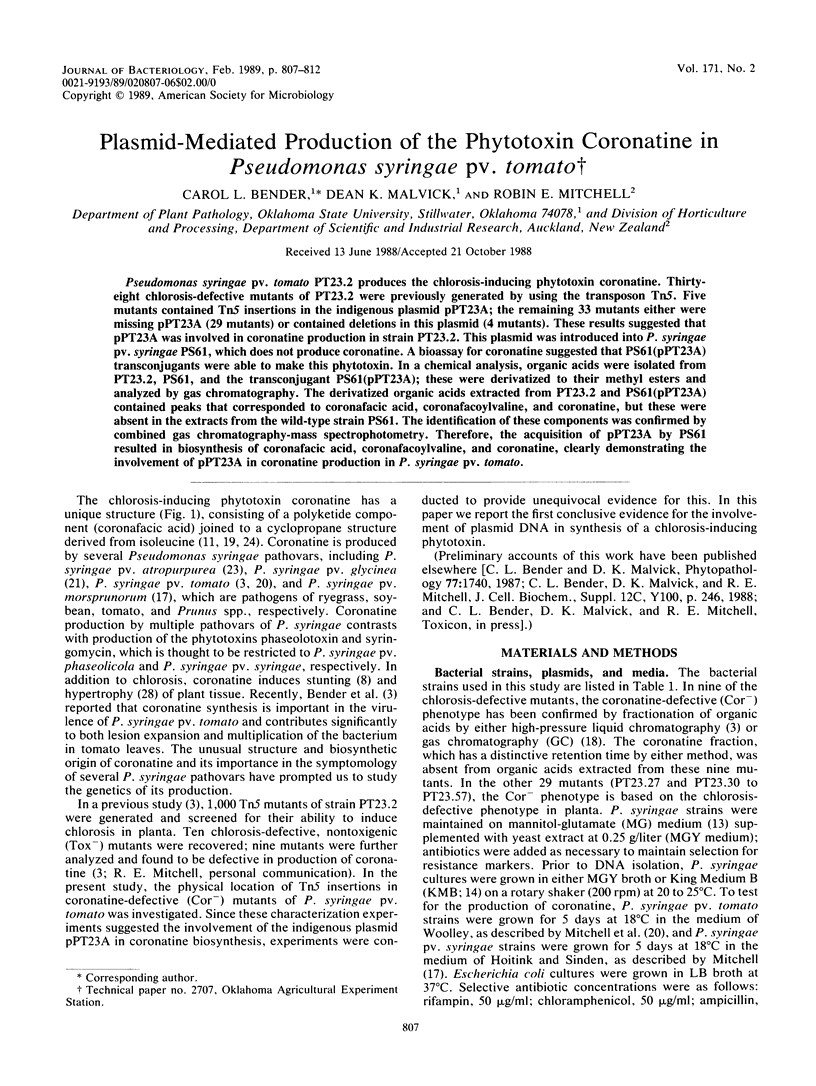Abstract
Pseudomonas syringae pv. tomato PT23.2 produces the chlorosis-inducing phytotoxin coronatine. Thirty-eight chlorosis-defective mutants of PT23.2 were previously generated by using the transposon Tn5. Five mutants contained Tn5 insertions in the indigenous plasmid pPT23A; the remaining 33 mutants either were missing pPT23A (29 mutants) or contained deletions in this plasmid (4 mutants). These results suggested that pPT23A was involved in coronatine production in strain PT23.2. This plasmid was introduced into P. syringae pv. syringae PS61, which does not produce coronatine. A bioassay for coronatine suggested that PS61(pPT23A) transconjugants were able to make this phytotoxin. In a chemical analysis, organic acids were isolated from PT23.2, PS61, and the transconjugant PS61(pPT23A); these were derivatized to their methyl esters and analyzed by gas chromatography. The derivatized organic acids extracted from PT23.2 and PS61(pPT23A) contained peaks that corresponded to coronafacic acid, coronafacoylvaline, and coronatine, but these were absent in the extracts from the wild-type strain PS61. The identification of these components was confirmed by combined gas chromatography-mass spectrophotometry. Therefore, the acquisition of pPT23A by PS61 resulted in biosynthesis of coronafacic acid, coronafacoylvaline, and coronatine, clearly demonstrating the involvement of pPT23A in coronatine production in P. syringae pv. tomato.
Full text
PDF





Images in this article
Selected References
These references are in PubMed. This may not be the complete list of references from this article.
- Bender C. L., Cooksey D. A. Indigenous plasmids in Pseudomonas syringae pv. tomato: conjugative transfer and role in copper resistance. J Bacteriol. 1986 Feb;165(2):534–541. doi: 10.1128/jb.165.2.534-541.1986. [DOI] [PMC free article] [PubMed] [Google Scholar]
- Bender C. L., Cooksey D. A. Molecular cloning of copper resistance genes from Pseudomonas syringae pv. tomato. J Bacteriol. 1987 Feb;169(2):470–474. doi: 10.1128/jb.169.2.470-474.1987. [DOI] [PMC free article] [PubMed] [Google Scholar]
- Crouse G. F., Frischauf A., Lehrach H. An integrated and simplified approach to cloning into plasmids and single-stranded phages. Methods Enzymol. 1983;101:78–89. doi: 10.1016/0076-6879(83)01006-x. [DOI] [PubMed] [Google Scholar]
- KING E. O., WARD M. K., RANEY D. E. Two simple media for the demonstration of pyocyanin and fluorescin. J Lab Clin Med. 1954 Aug;44(2):301–307. [PubMed] [Google Scholar]
- Malpartida F., Hopwood D. A. Physical and genetic characterisation of the gene cluster for the antibiotic actinorhodin in Streptomyces coelicolor A3(2). Mol Gen Genet. 1986 Oct;205(1):66–73. doi: 10.1007/BF02428033. [DOI] [PubMed] [Google Scholar]
- Morgan M. K., Chatterjee A. K. Isolation and characterization of Tn5 insertion mutants of Pseudomonas syringae pv. syringae altered in the production of the peptide phytotoxin syringotoxin. J Bacteriol. 1985 Oct;164(1):14–18. doi: 10.1128/jb.164.1.14-18.1985. [DOI] [PMC free article] [PubMed] [Google Scholar]
- Peet R. C., Lindgren P. B., Willis D. K., Panopoulos N. J. Identification and cloning of genes involved in phaseolotoxin production by Pseudomonas syringae pv. "phaseolicola". J Bacteriol. 1986 Jun;166(3):1096–1105. doi: 10.1128/jb.166.3.1096-1105.1986. [DOI] [PMC free article] [PubMed] [Google Scholar]
- Rhodes P. M., Hunter I. S., Friend E. J., Warren M. Recombinant DNA methods for the oxytetracycline producer Streptomyces rimosus. Biochem Soc Trans. 1984 Aug;12(4):586–587. doi: 10.1042/bst0120586. [DOI] [PubMed] [Google Scholar]
- Selvaraj G., Iyer V. N. Suicide plasmid vehicles for insertion mutagenesis in Rhizobium meliloti and related bacteria. J Bacteriol. 1983 Dec;156(3):1292–1300. doi: 10.1128/jb.156.3.1292-1300.1983. [DOI] [PMC free article] [PubMed] [Google Scholar]
- Staskawicz B. J., Dahlbeck D., Keen N. T. Cloned avirulence gene of Pseudomonas syringae pv. glycinea determines race-specific incompatibility on Glycine max (L.) Merr. Proc Natl Acad Sci U S A. 1984 Oct;81(19):6024–6028. doi: 10.1073/pnas.81.19.6024. [DOI] [PMC free article] [PubMed] [Google Scholar]




